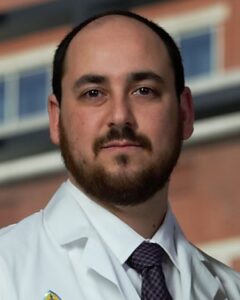Takeaway
Some patients are unable to understand the need for protective measures against COVID. Clinicians working with these patients are at increased risk, and may need to advocate for additional PPE for their healthcare team.

Passion in the Medical Profession | May 28, 2020 | 4 min read
By Paul Nestadt, MD, Johns Hopkins Medicine
I don’t think that I have COVID-19. I can’t be sure, because studies have found that anywhere between 20% and 80% of cases are asymptomatic. Of course, even fatal cases are present and infectious several days or a week before making themselves known.
However, I’m optimistic that I didn’t catch it today. I’d been worried. This morning, a CNA ran over to warn me that a patient I’d just examined had suddenly spiked a high fever.
This patient, as with most on our dual diagnosis psychiatric unit, came from an unstable housing situation. Most of our patients come from the streets, group homes, or jail. These are settings which, like the hospital itself, have relatively high rates of infection due to close quarters and inadequate resources. A recent study of a Boston homeless shelter found that 36% of residents tested positive for COVID and of those, almost 90% had no symptoms. In April, The New York Times crowned Chicago’s Cook County jail as the nation’s top virus hotspot.
Our patients are, by definition, too psychiatrically ill to be safe outside of the hospital. In many cases they can’t understand the need to physically distance, to wash hands or wear masks, to not hug or spit. Half of my patients this morning were under “constant observation”—a staff member must stay close at hand in order to be able to stop them if they impulsively attack others or themselves. A few more “active” patients also needed a security detail as back up. Our patients don’t wait patiently in bed to be visited. Their rooms don’t have phones or TVs, and we strongly encourage them to be out and about. The treatment process relies on their participation in the unit milieu, interacting in the common area, eating in a family style, and attending group therapy throughout the day. We aren’t designed for infection control, with our communal patient phone, open floor plan, and day area couches.
When I was told that my patient was febrile, I flinched. I’d done my best to maintain as much distance as possible, as I’ve done throughout the pandemic, though I had examined his sore knee. I was wearing my mask. It’s a paper disposable one that the hospital provided along with two brown paper storage bags, for reuse indefinitely. Usually we’re supposed to use these once, never for more than a few hours because they lose filtration efficacy and because they readily become petri dishes for everything that lands on them. Virus is notably detectable on surgical masks for seven days—longer than any other surface. Before March, reusing a disposable surgical mask could cost the hospital its accreditation.
I was given this one in late March and instructed to ask for a replacement only if it was torn or visibly soiled. Not that it matters, since surgical masks are designed to prevent the wearer from transmitting virus but do very little to prevent the wearer from contracting it. If today’s patient had been infected, I would be infected. My family would follow. I would put all of my other patients and coworkers at risk until symptoms manifested to trigger my self-quarantine. This logic has led some hospitals to provide N95s for all clinical work. It led China to require much more than that. It’s why I got in touch with personal protective equipment suppliers early in this pandemic. I learned that FDA-registered N95s are readily available but cost $2.63, whereas surgical masks are $0.39 each. That cost difference may be why many hospitals still rely on surgical masks, which provide minimal protection from infection. That difference may be why healthcare workers make up one in five cases of COVID-19 in the U.S..
My patient didn’t have a fever. He’d enjoyed a hot cup of coffee minutes before his temperature was checked. A great relief. But we don’t know who’s infectious, regardless of symptoms. We draw from high risk populations. We work in close proximity on open, interactive units, with disorganized, mentally ill patients, sometimes requiring physical holds and rarely able to maintain safe distances. It’s no coincidence that one of the first COVID clusters in Maryland was a psychiatric hospital, or that New Jersey’s psychiatric hospitals were also a battlefront.
Clinicians working on psychiatric units should advocate for themselves and their patients. Administrators and general hospital environmental control teams may not appreciate the unique risks of the psychiatric setting. We must remind them that patients won’t be able to reliably wear masks for source protection, and so N95s are more appropriate for staff.
Admission testing for patients is important, although it’s imperfect given the high false negative rate and the increased likelihood for mentally ill patients to refuse testing. Testing staff, at minimum for fever but ideally for the virus itself, may be warranted. Psychiatrists are accustomed to treating the most vulnerable of patients, and this vulnerability to COVID is no exception. But without adequate protection, we’re the ones putting these patients, and ourselves, at risk

